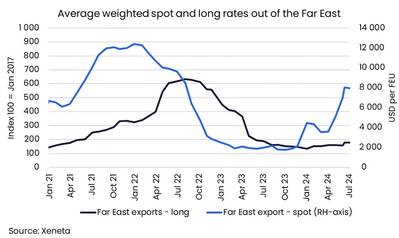Xeneta: Ocean Container Shipping Market Reaches Tipping Point
The ocean container shipping market reached a tipping point in July, with long term rates on major fronthaul trades showing signs of life just as spiraling short term rates begin to soften.
The Xeneta Global XSI®, which covers all valid long term contracts in the market, edged up 2.5% in July to stand at 151.5 points.
More notably, the underlying XSI® sub-index for Far East Exports – which includes the world’s biggest fronthaul trades to Europe and the US - increased 12.6% in July to 178.8 points.
This coincides with short term rates on major trades from the Far East to the US and Europe beginning to soften in July from the massive increases seen over recent months.
Emily Stausbøll, Xeneta Senior Shipping Analyst, said: “Long term ocean container shipping rates remained subdued despite massive increases on the short term market in May and June – but that is starting to change.
“For example, while short term rates on the Far East to US West Coast trade increased more than 140% between 30 April and 1 July, the long term market increased by 20%. However, short term rates to the US West Coast have fallen by 12% since 1 July, just as the long term market shows signs of life.”
Increasing long term rates and decreasing short term rates means the spread is narrowing between the markets, which presents a delicate balance ahead of long term contract negotiations between shippers and carriers later this year.
Stausbøll said: “This is a pivotal time for the market. The big question is, how high will long term rates climb before growth is stunted by the falling spot market?
“Shippers will be hoping the spot market crashes back down hard and fast, while carriers will be doing everything possible to keep short term rates elevated for as long as possible. Where the long and short term markets land at the point new contract negotiations begin will be crucial in determining whether shippers or carriers have the strongest hand.
“A few weeks ago, when spot rates were still spiraling, carriers would have been feeling confident about long term contract negotiations - but market sentiment can change very quickly. Shippers won’t want to see the long term market starting to increase because it has already been a bruising 2024 in the spot market. But they should have cautious optimism because, at the moment, it feels like there is more room for spot rates to fall than there is for long term rates to rise.”
Stausbøll reiterated that ocean supply chains remain under pressure and there are potential disruptions on the horizon.
“Diversions are still in place in the Red Sea, meaning the majority of container ships are continuing to sail around the Cape of Good Hope. There is the threat of union action at ports on the US East and Gulf Coasts, while a Trump presidency could see businesses rush to ship goods ahead of new tariffs on Chinese imports. There is also the risk of new geopolitical incidents, as we are seeing in Bangladesh where civil unrest is impacting port operations.
“It will not take much to push ocean supply chains back into the red and send spot rates heading upward once again, which would also have consequences for the long term market.”













